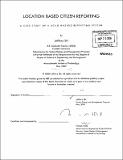| dc.contributor.advisor | Patrick Hale. | en_US |
| dc.contributor.author | Shi, Jeffery (Jeffery Xin) | en_US |
| dc.contributor.other | System Design and Management Program. | en_US |
| dc.date.accessioned | 2010-05-25T21:09:07Z | |
| dc.date.available | 2010-05-25T21:09:07Z | |
| dc.date.copyright | 2009 | en_US |
| dc.date.issued | 2009 | en_US |
| dc.identifier.uri | http://hdl.handle.net/1721.1/55243 | |
| dc.description | Thesis (S.M.)--Massachusetts Institute of Technology, System Design and Management Program, 2009. | en_US |
| dc.description | Cataloged from PDF version of thesis. | en_US |
| dc.description | Includes bibliographical references. | en_US |
| dc.description.abstract | Mobile phone ownership is approaching 90% of the population in the United State and most of developed countries. Among the developing countries, it's estimated that 1 billion mobile phone users will come on-line within a year. Mobile phones penetrated our society and daily lives, and unlike any other devices, it also exhibits some unique characteristics. A mobile phone is almost always on, always connected, and always with you. In case of more advanced phones, it even knows where you are and how you move. These conditions provided a perfect breeding ground for a new form of Citizen Reporting system, location-based citizen reporting. A well designed and most advanced system must solve a real problem. The problem in this thesis describes the ever increasing road hazard problem in the United States, caused by our ageing road infrastructures and extreme weather patterns. This thesis proposes a citizen reporting system that is based on mobile technology and location based service to minimize the damages caused by road hazards each year. The structure of the thesis consists of two parts. In Part 1, this thesis will first explain what a citizen reporting system is and what location based service is. The thesis will then present some details about the advantages and disadvantages of each concept. Finally, this thesis will provide some examples of location based citizen reporting systems. The purpose of Part I is to lay down the basic concepts that will be used in Part II. | en_US |
| dc.description.abstract | (cont.) Part II of the thesis will focus on presenting a solution to the problem by introducing Hazard Spy, a road hazard reporting system. Part II will be presented from the prospective of an entrepreneur who is seeking to launch such a hazard reporting system as a viable venture. The thesis will examine both the business side and technical side of this venture and present a complete business plan as the result. Research methods used in this thesis include literature reviews, online sources, surveys, interviews, and field observations. Many of the frameworks and methods used in this thesis were introduced in the SDM core and elective classes (both business classes and engineering classes), including System Architecture, System Project Management, Tech Strategy, Product Design and Development, Marketing Management, Finance Theory, Financial Accounting, New Enterprise, and Mobile Programming. The conclusion of this thesis is that the critical technology components for a location-based citizen reporting system that can alleviate the road hazard problem are already exist today in the U.S. These components have enough speed, accuracy, portability and their prices are in the range of affordability. In fact, some smartphones on the market today have all of the required technology natively. However, challenges are still laying in wait for combining these technologies into a marketable product and for launching such a product into a viable venture. The proposed product and business plan in this thesis can be one possible path to success. | en_US |
| dc.description.statementofresponsibility | by Jeffery Shi. | en_US |
| dc.format.extent | [1], 82 p. | en_US |
| dc.language.iso | eng | en_US |
| dc.publisher | Massachusetts Institute of Technology | en_US |
| dc.rights | M.I.T. theses are protected by
copyright. They may be viewed from this source for any purpose, but
reproduction or distribution in any format is prohibited without written
permission. See provided URL for inquiries about permission. | en_US |
| dc.rights.uri | http://dspace.mit.edu/handle/1721.1/7582 | en_US |
| dc.subject | System Design and Management Program. | en_US |
| dc.title | Location based citizen reporting : a case study of a road hazard reporting system | en_US |
| dc.title.alternative | Mobile citizen reporting mechanism : a case study of launching a venture for road hazard reporting system | en_US |
| dc.title.alternative | Case study of a road hazard reporting system | en_US |
| dc.type | Thesis | en_US |
| dc.description.degree | S.M. | en_US |
| dc.contributor.department | System Design and Management Program. | en_US |
| dc.identifier.oclc | 612306838 | en_US |

